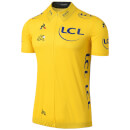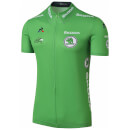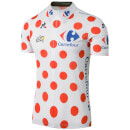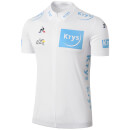Over the course of the three-week Tour, the professional peloton will be racing for a number of jerseys. Inevitably, the best all-round rider wins the Yellow Jersey from Le Coq Sportif. All leader’s jerseys are won by following the same concept, here’s how the rules go:
The points of every rider are tracked throughout the Tour and after every stage the rider with the most accumulative points wins the respective jersey (overall, climbing, sprinting, and youngster). After the final stage of the Tour, the jersey winners are those who have achieved the most points in the respective disciplines overall across the entire Tour.
Many people query why Mark Cavendish leads the field on countless sprint stages but has never been the wearer of yellow. This is where the variety in the route divides the peloton and affects those who are weak in certain areas. To take Cavendish as an example, he is not necessarily the strongest climber so struggles in the mountain stages. This sets him aback in terms of general classification points as he is unable to climb to the top as quick as the climbers in the peloton, so unfortunately his chances of winning the yellow jersey lessen. But the competition doesn’t end with yellow! As mentioned before, riders have the opportunity to play to their strengths as there are different jerseys for sprinting and climbing too, as well as a young rider’s classification. Here’s a little more about each jersey:
Tour de France Jerseys
-
Yellow Jersey
This general classification jersey is one that everyone keeps their eyes on. The yellow jersey is awarded to the overall best rider from the Tour and with this title, you are deemed the road cycling King.Why is the jersey yellow? Well, the famous Yellow Jersey became the colour it is simply because the company that started up the Tour de France printed their articles on yellow paper. There was no debate and yellow it was and has stayed ever since. It wasn’t until 1919 that they thought it would also make it a great way to spot the leader of the race and who was currently in the lead at the time, and thus, the general classification jersey was born!Previous winners:
2016 – Chris Froome (Team Sky)2015 – Chris Froome (Team Sky)2014 – Vincenzo Nibali (Astana)2013 – Chris Froome (Team Sky) -
Green Jersey
Also known as the Points Classification Jersey, the wearer of the Green Jersey is the sprinter who has lead the peloton by getting their hands on the most points in the intermediate sprints and stage finishes throughout the Tour. This classification was introduced to the Tour in 1953 for its 50th anniversary, bringing a new interest and dimension to the race.Previous winners:2016 – Peter Sagan (Tinkoff)2015 – Peter Sagan (Tinkoff)2014 – Peter Sagan (Tinkoff)2013 – Peter Sagan (Tinkoff) -
Polka Dot Jersey
Introduced in 1933 to cycling tours, the King of the Mountains jersey comes as red polka dots on a white cycling jersey. The Tour de France first saw this jersey in 1975, awarding the Polka Dot Jersey to the ‘best climber’ who accumulates the most points in the mountain stages.Previous winners:
2016 – Rafal Majka (Tinkoff)2015 – Chris Froome (Team Sky)2014 – Rafal Majka (Tinkoff)2013 – Nairo Quintana (Movistar) -
White Jersey (Young Rider's)
This is one for the youngsters in the Tour de France. The best young rider in the overall standings under the age of 25 is crowned with the white jersey. It was created in 1975, but removed from the Tour in 1988 despite keeping the best young rider classification. It was only sixteen years ago when the white jersey returned to the Tour de France, revealing the best young talents in the sport.Previous winners:
2016 – Adam Yates (OBE)2015 – Nairo Quintana (Movistar)2014 – Thibaut Pinot (FDJ)2013 – Nairo Quintana (Movistar)
http://www.probikekit.co.uk/blog/events/jerseys-tour-de-france/





没有评论:
发表评论